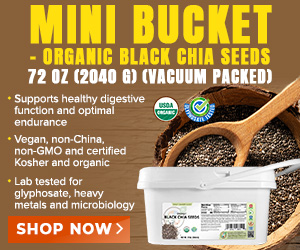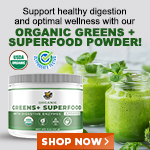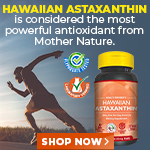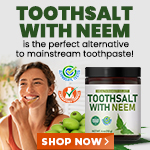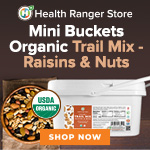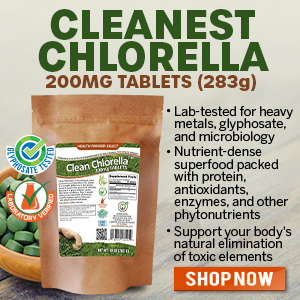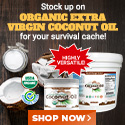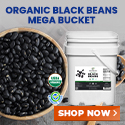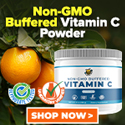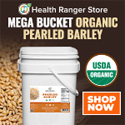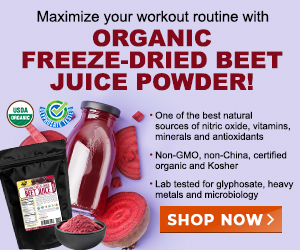
Wild Pacific Salmon Explained
Wednesday, April 01, 2009 by: Kirk Patrick
Tags: wild salmon, health news, Natural News
- Newly released JFK files reveal Pentagon's role in creating Lyme disease and covid in the same lab
- Dr. Suzanne Humphries makes bombshell appearance on Joe Rogan podcast, exposing vaccine industry deception back to POLIOMYELITIS
- L.A.'s rebuilding nightmare: Only 4 permits issued after fire destroys 6,000 homes
- Discovery of vast underground city beneath Giza pyramids challenges human history
- Black cumin seed oil emerges as a powerful ally against breast cancer and chronic inflammation
- PROCESSED TABLE SALT in foods found to fuel depression
- Here are TEN all-natural ways to protect your garden without using harmful chemicals
- Ginseng's hidden anti-aging power: How compound K is rewriting the rules of skincare
- “Independent” anti-Russia outlet MEDUZA faces COLLAPSE as US funding dries up
- Catastrophic 7.7 earthquake devastates Myanmar and Thailand; death toll could reach 100,000
- The hidden battle in your glass: How A1 and A2 milk could shape your health
- AI breakthrough slashes celiac disease diagnosis time from months to minutes
- CDC finally halts $11 billion COVID funding scam as health officials admit the ‘pandemic’ was a fraud
- BPA: The hidden hormone disruptor sabotaging your health - and how to fight back
- Sugar-free deception: Artificial sweeteners hijack hunger signals, fuel obesity epidemic, study warns
- Europe braces for WAR as EU urges citizens to STOCKPILE FOOD, in latest provocations with Russia
- “Endgame: The Hidden Agenda 21” unveils a world of conspiracy and control
- Putin vows to 'finish off' Ukraine, accuses West of prolonging the war
- Newly released JFK files reveal Pentagon's role in creating Lyme disease and covid in the same lab
- Analysis: The coming economic collapse, a mass uprising and Trump's three secret weapons to halt the growing revolt
- Festive flavors: The sweet history, nutritional profile and health benefits of pecan pie
- Elon Musk: Aliens could be here on Earth RIGHT NOW
- Trump reverses course on Gaza plan, says “nobody is expelling Palestinians”
- Big Pharma's $8 Billion bribery scheme exposed: how doctors are pushed to prescribe junk science, not heal
- Boys are back in town: Trump’s patriotic alpha crew takes the wheel while toxic females ride in the backseat
- Reclaim your health: How midlife exercise reverses years of inactivity
- A lack of integrity in Academia: Harvard professor found GUILTY of fraudulent research to promote CRT theory
- Survival 101: Effective EMF blocking techniques
- EPA advisor admits the agency is funneling billions to climate groups ahead of Trump’s return to White House
- Dr. Mike Yeadon releases 15-minute testimony - WATCH - about genocidal intent of COVID “vaccines”
- 5 Simple steps to boost your brainpower: How to strengthen executive function in a distracted world
- Florida takes a stand: DeSantis proposes permanent ban on mRNA vaccine mandates
- Sugarcane extract superior to cholesterol-lowering drugs?
- Mike Adams Sermon 66: God will DESTROY ISRAEL for its wickedness
- Pilots report mysterious lights 'moving at extreme speeds' across Oregon skies
- Space war brewing? Russia threatens to destroy Starlink satellites
- EPA advisor admits the agency is funneling billions to climate groups ahead of Trump’s return to White House
- California's social media censorship law struck down: A victory for free speech or a threat to online safety?
- The Health Ranger releases “Vaccine Zombie” song and music video, using AI-animated zombies for the music video
- Dr. Mike Yeadon releases 15-minute testimony - WATCH - about genocidal intent of COVID “vaccines”
- The pandemic as a tool for INDOCTRINATION: Understanding “The Indoctrinated Brain” by Dr. Michael Nehls
- Newly released JFK files reveal Pentagon's role in creating Lyme disease and covid in the same lab
- Florida takes a stand: DeSantis proposes permanent ban on mRNA vaccine mandates
- Mike Adams releases country western hit single: Goin’ Back in Time is Comin’ Home
- Mike Adams releases music poetry sensation: A Child of God
- “Why we influenced the 2020 elections”: Facebook files reveal the coordinated effort to bury the Hunter Biden laptop story
- Unpacking the Lies That We’ve Been Fed – new song and music video released by Mike Adams, the Health Ranger
- RFK Jr. clears key hurdle: Sen. Susan Collins backs controversial HHS nominee, signaling a new era for health policy
- Mike Adams releases new song and music video: Nothing More Disgusting Than a Globalist
- Michigan sheriff announces criminal investigation into 2020 election crimes, Dominion Voting Systems
- Israeli soldiers accused of even more torture and abuse in the West Bank
- Migrants are taking advantage of recent hurricanes to scam residents and loot their homes
- House Intelligence Committee calls for the ARREST and PROSECUTION of Dr. Anthony Fauci
- Rep. Nancy Mace introduces bill to ban biological males from female facilities on federal property
- Red Cross issues warning to stop blood plasma donations from vaccinated people
- Scientists confirm: GENIUS brain function can be spontaneously unleashed in humans without any apparent cause
- EPA advisor admits the agency is funneling billions to climate groups ahead of Trump’s return to White House
- HYSSOP: What research reveals about the health benefits of this ancient holy herb
- Two containers with completed ballots fall out of truck in Florida
- Fully vaccinated about to see “tsunami” of illness and death, warns virologist
- Global leaders unite to clamp down on “misinformation” with UN-backed Cascais Declaration
- BREAKING: 2025 NDAA authorizes mandatory military draft of WOMEN across America… as Pentagon pursues global NUCLEAR war with both Russia and China at the same time
- Michael Yon warns of a ZIONIST TAKEOVER in Trump’s second administration
- BOMBSHELL: DNA testing kits are a SCAM to develop ethnic-specific bioweapons
- Ozempic and Wegovy weight loss drugs are injectable LIZARD VENOM PEPTIDES that may unleash a devastating wave of organ failure… side effects align with symptoms of SNAKE BITES
- Israeli soldiers accused of even more torture and abuse in the West Bank
- These 13 countries just signed an agreement to engineer a global FAMINE by destroying food supply
- NASA admits that climate change occurs because of changes in Earth’s solar orbit, and NOT because of SUVs and fossil fuels
- RFK Jr. clears key hurdle: Sen. Susan Collins backs controversial HHS nominee, signaling a new era for health policy
- Sermon 30: How Jesus reveals Caesar’s FAKE CURRENCY and FALSE AUTHORITY
- Coriander seeds: Ancient medicine backed by modern science
- Arizona officials claim Maricopa County needs 10-13 days to tabulate results of the election
With seafood in general, higher fat content is highly beneficial (yes!) because fattier fish can survive being frozen and thawed without becoming mushy. While certain types of Salmon rank among the fattiest of all fish, don't worry: it is the "good" fat. Along with offering half the recommended daily allowance of Vitamin A and Vitamin D in a single serving, the oil in Salmon features two otherwise rare compounds known to offer highly protective cardiovascular and neurological benefits: E.P.A. (Eicosapentaenoic Acid) and D.H.A. (Docosahexaenoic Acid).
The Antioxidant Astaxanthin
The deep reddish orange color (called `Salmon Pink`) that occurs in real Salmon is a natural result of their traditional diet featuring krill (and/or fish that eat krill). This pigment, the carotenoid Astaxanthin is also a powerful antioxidant with many known health benefits:
* Helps prevent bladder cancer.
* Stimulates the immune system.
* Protects the retina from oxidative damage.
* Easily crosses the blood brain barrier.
* Useful to treat Alzheimer`s disease, Parkinsons disease and other nervous system disorders.
The Pacific Salmon Family
The five species of the Salmonidae family are highly unique and each deserves a careful look. Note that fish contain much higher body fat percentage during the early spawning process.
* King Salmon (Chinook) [Oncorhynchus tshawytscha] - The largest of all Salmon, the King Salmon is the most desirable species for several reasons: it has the highest percentage of body fat, the most Omega 3, and (many feel) the best flavor. Only a few fish such as Mackerel and Herring contain a higher percentage of fat than "Chinook Salmon". King Salmon is available in several pigment variations including red, white and marbled flesh. (5 out of 5 stars) 15-35% fat.
* Red Salmon (Sockeye) [Oncorhynchus nerka] - Red Salmon eat only Krill and Phytoplankton as opposed to fish, so they have the most Astaxanthin and obtain a noticeably deeper orange hue than other species. "Sockeye Salmon" are unique in that they require a lake for spawning. (4 out of 5 stars) 10%-22% fat.
* Silver Salmon (Coho) [Oncorhynchus kisutch] - Though having a lower fat content, the smaller Silver Salmon can taste close to Sockeye if from a reliable source but they normally do not contain the same amount of Omega 3 or Astaxanthin. "Coho Salmon" were introduced to the Great Lakes, first in 1873 and then successfully in the 1960's. (3 out of 5 stars) 5%-15% fat.
* Pink Salmon (Humpback) [Oncorhynchus gorbuscha] - The smallest and most abundant of Pacific Salmon, the Pink Salmon have a distinguished humpback. "Humpback Salmon" were more popular in the early 20th century until stocks declined drastically in the 1940`s and 1950`s. Bright silver when in the ocean and turning gray and yellow during spawning, "Humpies" are not as flavorful as premium kinds due to lower fat content. Pink Salmon are generally only found canned though at a fraction of the cost of premium species. (2 out of 5 stars) 3%-9% fat.
* Chum Salmon (Dog) [Oncorhynchus keta] - Chum Salmon is the type found at discount grocers in the frozen section. The outer skin of Chum Salmon is unusual and resembles tie-dye. "Dog Salmon" do not naturally obtain the same intensity of orange as the others. "Spring Chum" is said to taste great when obtained fresh. (1 out of 5 stars) 2%-5% fat.
The primary Salmon naming convention is somewhat puzzling. While the last four species were named after their color: Red, Silver, Pink and Chum (which means varied color), the first one (King) doesn`t follow the pattern. It`s like enumerating them A, B, C, D and 5. Meanwhile, the stories behind the Native American names (Chinook, Sockeye and Coho) are anyone`s guess.
Alaskan Salmon Habitat
Salmon are born in fresh water, migrate to salt water, and later return to fresh water to spawn and the life cycle repeats (this type of fish is called Anadarous). Salmon spend their adult life in the ocean where they must put on enough body weight to make their return journey. Migrating Salmon do not eat along the way. All other things being equal, the longer Salmon have to travel, the higher amount of body fat and the tastier the fish.
While some areas of the Pacific Northwest and British Columbia are experiencing declining stocks of Salmon along with problems from fish farming, wild Salmon are still abundant in much of Alaska where laws protecting Salmon are more strict. It is still important however to find small fisheries that practice sustainable harvesting methods.
There are several popular Salmon hangouts in Alaska:
* Kodiak Island - Said to feature so many Salmon during mid-year that the bears get noticeably bigger from eating them, Kodiak island turns a special shade of emerald green in late spring hence the name "Emerald Island".
* Copper River - The pristine Copper River in Alaska is 287 miles long and empties into Prince William Sound. Wild Salmon travel through rapids on their return trip so only those in top shape live to reproduce. The Copper River is the most popular source of gourmet Salmon.
* Yukon River - The longest and northernmost river in the Salmon`s habitat is the Yukon River that stretches 2300 miles. Yukon Salmon must have enormous reserves of body fat to make the journey, containing up to twice the oil of Copper River Salmon (34% versus 17%).
While the Copper River continues to be compromised by logging and roads, pollution in the Yukon is mainly due to the mining of metals (there`s less Copper in the Copper). Both rivers are still relatively clean compared to other U.S. rivers and are not listed as contaminated waterways by the Environmental Protection Agency. As with any water source some areas are cleaner than others, so it`s best to find a retailer that regularly tests their fish for heavy metals. Mercury is a neurotoxin, and although wild Salmon are known to be among the purest of all ocean fish, wild and crazy Salmon should be avoided.
Threats to Wild Salmon
There are several dangerous trends that threaten the Salmon itself, its habitat, the consumers who enjoy them and the communities based on them:
1) Genetically Modified Salmon - GMO Salmon are kept in fenced areas in the ocean and ultimately some will escape where they could multiply and overcrowd native fish out of existence, after which they would certainly die off themselves. Bred to grow faster, GMO Salmon eat everything in sight and (some even eat each other!), and this would eventually mean no Salmon at all.
2) Sea Lice - A naturally occurring pest, Sea Lice only become a problem in areas where fish are overcrowded into fenced areas. The lice swim through the fence into the ocean where they infect young, nearby wild Salmon.
3) Counterfeit Wild Salmon - Superstores often use deceptive marketing techniques, selling "Wild Salmon" that is artificially colored. Some is actually not wild at all. The tell-tale sign of farm-raised Salmon is that it does not stay pink after it is cooked (artificial colors fade under heat, unlike real Salmon pigment). If a restaurant doesn't tell you the Salmon is wild, it's farm raised.
4) Globalism - Some fish caught in the Pacific Northwest are actually shipped to China for processing only to be later shipped back and sold in the US! So much for catch of the day. Some even want a new (NAFTA) superhighway to get the fish back here faster!
Summary
Chances are that next time you are offered Salmon you will know what questions to ask to learn exactly what kind of Salmon it is. There remains however the serious risk that you might now be called a Salmon Snob.
_______________________
References:
Chum Salmon, Pink Salmon Nutritional Content:
http://www.edf.org/page.cfm?tagID=15801
King Salmon
http://www.edf.org/page.cfm?tagID=15776
Sea Lice Threaten BC
http://www.farmedanddangerous.org/page/seali...
Genetically Modified Salmon
http://organic.com.au/news/2004.06.14/
Asathanxin Online
http://www.astaxanthin.org
About the author
Kirk Patrick has studied natural medicine for over a decade and has helped many people heal themselves.Wild salmon at FETCH.news
Get independent news alerts on natural cures, food lab tests, cannabis medicine, science, robotics, drones, privacy and more.
Take Action: Support Natural News by linking to this article from your website
Permalink to this article:
Embed article link: (copy HTML code below):
Reprinting this article:
Non-commercial use OK, cite NaturalNews.com with clickable link.
Follow Natural News on Facebook, Twitter, Google Plus, and Pinterest
Science News & Studies
Medicine News and Information
Food News & Studies
Health News & Studies
Herbs News & Information
Pollution News & Studies
Cancer News & Studies
Climate News & Studies
Survival News & Information
Gear News & Information
News covering technology, stocks, hackers, and more



"Big Tech and mainstream media are constantly trying to silence the independent voices that dare to bring you the truth about toxic food ingredients, dangerous medications and the failed, fraudulent science of the profit-driven medical establishment.
Email is one of the best ways to make sure you stay informed, without the censorship of the tech giants (Google, Apple, Facebook, Twitter, YouTube, etc.). Stay informed and you'll even likely learn information that may help save your own life."
–The Health Ranger, Mike Adams










